The Interplay between Parameters of Light Pollution and Energy Efficiency for Outdoor Amenity Lighting
Abstract
1. Introduction
2. Upward Light Ratio and Upward Flux Ratio
- is the upward light ratio [%]
- is the luminous flux emitted directly into the upper hemisphere [lm]
- is the total luminous flux of all luminaires used [lm]
- is the upward flux ratio [-]
- is the average maintained illuminance achieved in the given solution (design) [lx]
- is the average maintained illuminance required on the task area (from the lighting standard) [lx]
- is the maintenance factor [-]
- is the utilisation factor [%]
- is the upward light output ratio in given luminaires position [-]
- is the downward light output ratio in given luminaires position [-]
- is the reflectance of task area [-]
- is the reflectance of surroundings [-]
- is the maximum luminous flux emitted upwards in a given lighting solution [lm]
- is the minimum value of the luminous flux emitted upwards in an ideal situation [lm]
3. Material and Methods
3.1. Research Hypotheses
- I.
- The UFR criterion values are too high, not adapted to the current capabilities of lighting equipment, and must be strictly lowered;
- II.
- There is a strong interplay between UFR and NPD. Therefore, the light pollution from amenity lighting installation can be assessed by the value of NPD.
3.2. Multi-Variant Simulation Studies
- is the utilance [%]
- is the useful luminous flux [lm]
- is the total luminous flux of all luminaires used [lm]
- is the normalized power density [W/m2|100 lx]
- is the lighting power density [W/m2]
- is the average maintained illuminance achieved in the given solution (design) [lx]
- ▪
- Two parking lots with the area of 10,000 m2: 100 m × 100 m and 50 m × 200 m;
- ▪
- Two arrangements of luminaires: poles located on the edges of the parking lot and the parking lot surface, and poles located only on the parking lot surface. In both cases, the arrangement of poles is even and symmetrical concerning the symmetry axis of the parking lot shape (Figure 3);
- ▪
- Six different types (A–F) of luminous intensity distributions of the LED luminaire with the same luminous flux of 10,000 lm (Figure 4). The active power of the luminaires is from 68 W to 76 W, corresponding with luminaire luminous efficacy of 147 lm/W and 132 lm/W, respectively;
- ▪
- Three tilts of the luminaires: 0°, 15°, 30°;
- ▪
- Three mounting heights of luminaires: 9 m, 12 m, and 15 m;
- ▪
- Two maintenance factors of 0.71 and 0.91 correspond to a relatively small (110%) and relatively large (140%) oversizing of lighting level.
4. Results and Discussion
5. Conclusions
Author Contributions
Funding
Data Availability Statement
Conflicts of Interest
References
- Wakefield, A.; Broyles, M.; Stone, E.L.; Harris, S.; Jones, G. Quantifying the attractiveness of broad-spectrum street lights to aerial nocturnal insects. J. Appl. Ecol. 2018, 55, 714–722. [Google Scholar] [CrossRef]
- Ouyang, J.Q.; de Jong, M.; van Grunsven, R.H.A.; Matson, K.D.; Haussmann, M.F.; Meerlo, P.; Visser, M.E.; Spoelstra, K. Restless roosts: Light pollution affects behavior, sleep, and physiology in a free-living songbird. Glob. Chang. Biol. 2017, 23, 4987–4994. [Google Scholar] [CrossRef] [PubMed]
- Pauwels, J.; Le Viol, I.; Bas, Y.; Valet, N.; Kerbiriou, C. Adapting street lighting to limit light pollution’s impacts on bats. Glob. Ecol. Conserv. 2021, 28, e01648. [Google Scholar] [CrossRef]
- Brayley, O.; How, D.M.; Wakefield, D.A. Biological Effects of Light Pollution on Terrestrial and Marine Organisms. Int. J. Sustain. Light. 2022, 24, 13–38. [Google Scholar] [CrossRef]
- Prakash, R.; Hossain, A.M.; Pal, U.N.; Kumar, N.; Khairnar, K.; Mohan, M.K. Dielectric Barrier Discharge based Mercury-free plasma UV-lamp for efficient water disinfection. Sci. Rep. 2017, 7, 17426. [Google Scholar] [CrossRef]
- Vandersteen, J.; Kark, S.; Sorrell, K.; Levin, N. Quantifying the Impact of Light Pollution on Sea Turtle Nesting Using Ground-Based Imagery. Remote Sens. 2020, 12, 1785. [Google Scholar] [CrossRef]
- Falchi, F.; Cinzano, P.; Duriscoe, D.; Kyba, C.C.M.; Elvidge, C.D.; Baugh, K.; Portnov, B.A.; Rybnikova, N.A.; Furgoni, R. The new world atlas of artificial night sky brightness. Sci. Adv. 2016, 2, e1600377. [Google Scholar] [CrossRef]
- Barentine, J.C.; Walker, C.E.; Kocifaj, M.; Kundracik, F.; Juan, A.; Kanemoto, J.; Monrad, C.K. Skyglow changes over Tucson, Arizona, resulting from a municipal LED street lighting conversion. J. Quant. Spectrosc. Radiat. Transf. 2018, 212, 10–23. [Google Scholar] [CrossRef]
- Jechow, A.; Kolláth, Z.; Ribas, S.J.; Spoelstra, H.; Hölker, F.; Kyba, C.C.M. Imaging and mapping the impact of clouds on skyglow with all-sky photometry. Sci. Rep. 2017, 7, 1–10. [Google Scholar] [CrossRef]
- Jechow, A.; Hölker, F.; Kolláth, Z.; Gessner, M.O.; Kyba, C.C.M. Journal of Quantitative Spectroscopy & Radiative Transfer Evaluating the summer night sky brightness at a research fi eld site on Lake Stechlin in northeastern Germany. J. Quant. Spectrosc. Radiat. Transf. 2016, 181, 24–32. [Google Scholar] [CrossRef]
- Septem, L.; Izzuddin, A.; Aria, J.; Airin, K.; Abu, F.; Herdiwijaya, D.; Hidayat, T.; Anugraha, R.; Sungging, E. Data analysis techniques in light pollution: A survey and taxonomy. New Astron. Rev. 2022, 95, 101663. [Google Scholar] [CrossRef]
- Pothukuchi, K. City Light or Star Bright: A Review of Urban Light Pollution, Impacts, and Planning Implications. J. Plan. Lit. 2021, 36, 155–169. [Google Scholar] [CrossRef]
- Fryc, I.; Bará, S.; Aubé, M.; Barentine, J.C.; Zamorano, J. On the Relation between the Astronomical and Visual Photometric Systems in Specifying the Brightness of the Night Sky for Mesopically Adapted Observers. LEUKOS J. Illum. Eng. Soc. North Am. 2021, 18, 447–458. [Google Scholar] [CrossRef]
- Bertolo, A.; Binotto, R.; Ortolani, S.; Sapienza, S. Measurements of night sky brightness in the Veneto Region of Italy: Sky quality meter network results and differential photometry by digital single lens reflex. J. Imaging 2019, 5, 56. [Google Scholar] [CrossRef] [PubMed]
- Karpińska, D.; Kunz, M. Device for automatic measurement of light pollution of the night sky. Sci. Rep. 2022, 12, 16476. [Google Scholar] [CrossRef]
- Ściężor, T. The impact of clouds on the brightness of the night sky. J. Quant. Spectrosc. Radiat. Transf. 2020, 247, 106962. [Google Scholar] [CrossRef]
- Tabaka, P. Pilot measurement of illuminance in the context of light pollution performed with an unmanned aerial vehicle. Remote Sens. 2020, 12, 2124. [Google Scholar] [CrossRef]
- Bouroussis, C.A.; Topalis, F.V. Assessment of outdoor lighting installations and their impact on light pollution using unmanned aircraft systems—The concept of the drone-gonio-photometer. J. Quant. Spectrosc. Radiat. Transf. 2020, 253, 107155. [Google Scholar] [CrossRef]
- Hänel, A.; Posch, T.; Ribas, S.J.; Aubé, M.; Duriscoe, D.; Jechow, A.; Kollath, Z.; Lolkema, D.E.; Moore, C.; Schmidt, N.; et al. Measuring night sky brightness: Methods and challenges. J. Quant. Spectrosc. Radiat. Transf. 2018, 205, 278–290. [Google Scholar] [CrossRef]
- Galatanu, C.D.; Husch, M.; Canale, L.; Lucache, D. Targeting the Light Pollution: A Study Case. In Proceedings of the 2019 IEEE International Conference on Environment and Electrical Engineering and 2019 IEEE Industrial and Commercial Power Systems Europe (EEEIC/I&CPS Europe), Genova, Italy, 11–14 June 2019. [Google Scholar] [CrossRef]
- Czyżewski, D. The Photometric Test Distance in Luminance Measurement of Light-Emitting Diodes in Road Lighting. Energies 2023, 16, 1199. [Google Scholar] [CrossRef]
- Słomiński, S.; Krupiński, R. Luminance distribution projection method for reducing glare and solving object-floodlighting certification problems. Build. Environ. 2018, 134, 87–101. [Google Scholar] [CrossRef]
- Gallaway, T.; Olsen, R.N.; Mitchell, D.M. The economics of global light pollution. Ecol. Econ. 2010, 69, 658–665. [Google Scholar] [CrossRef]
- Contín, M.A.; Benedetto, M.M.; Quinteros-Quintana, M.L.; Guido, M.E. Light pollution: The possible consequences of excessive illumination on retina. Eye 2016, 30, 255–263. [Google Scholar] [CrossRef] [PubMed]
- Ngarambe, J.; Lim, H.S.; Kim, G. Light pollution: Is there an Environmental Kuznets Curve? Sustain. Cities Soc. 2018, 42, 337–343. [Google Scholar] [CrossRef]
- Cafuta, M.R. Sustainable city lighting impact and evaluation methodology of lighting quality from a user perspective. Sustainability 2021, 13, 3409. [Google Scholar] [CrossRef]
- Peña-García, A.; Sędziwy, A. The Journal of the Illuminating Engineering Society Optimizing Lighting of Rural Roads and Protected Areas with White Light: A Compromise among Light Pollution, Energy Savings, and Visibility Optimizing Lighting of Rural Roads and Protected Areas with. LEUKOS 2020, 16, 147–156. [Google Scholar] [CrossRef]
- Bumgarner, J.R.; Nelson, R.J.; Liu, J.A.; Mel, O.H. Hormones and Behavior Effects of light pollution on photoperiod-driven seasonality. Horm. Behav. 2022, 141, 105105. [Google Scholar] [CrossRef]
- Sung, C.Y. Examining the effects of vertical outdoor built environment characteristics on indoor light pollution. Build. Environ. 2022, 210, 108724. [Google Scholar] [CrossRef]
- Schulte-Römer, N.; Meier, J.; Dannemann, E.; Söding, M. Lighting professionals versus light pollution experts? Investigating views on an emerging environmental concern. Sustainability 2019, 11, 1696. [Google Scholar] [CrossRef]
- Schulte-Römer, N.; Meier, J.; Söding, M.; Dannemann, E. The LED Paradox: How Light Pollution Challenges Experts to Reconsider Sustainable Lighting. Sustainability 2019, 11, 6160. [Google Scholar] [CrossRef]
- Lim, H.S.; Ngarambe, J.; Kim, J.T.; Kim, G. The Reality of Light Pollution: A Field Survey for the Determination of Lighting Environmental Management Zones in South Korea. Sustainability 2018, 10, 374. [Google Scholar] [CrossRef]
- Doulos, L.T.; Sioutis, I.; Kontaxis, P.; Zissis, G.; Faidas, K. A decision support system for assessment of street lighting tenders based on energy performance indicators and environmental criteria: Overview, methodology and case study. Sustain. Cities Soc. 2019, 51, 101759. [Google Scholar] [CrossRef]
- Skarżyński, K.; Żagan, W. Improving the quantitative features of architectural lighting at the design stage using the modified design algorithm. Energy Rep. 2022, 8, 10582–10593. [Google Scholar] [CrossRef]
- Kretzer, D.M. High-mast lighting as an adequate way of lighting pedestrian paths in informal settlements ? Dev. Eng. 2020, 5, 100053. [Google Scholar] [CrossRef]
- Novak, T.; Becak, P.; Dubnicka, R.; Raditschova, J.; Gasparovsky, D.; Valicek, P.; Ullman, J. Modelling of Luminous Flux Directed to the Upper Hemisphere from Electrical Substation before and after the Refurbishment of Lighting Systems. Energies 2022, 15, 345. [Google Scholar] [CrossRef]
- Wang, T.; Xue, L.; Brimblecombe, P.; Lam, Y.F.; Li, L.; Zhang, L. Ozone pollution in China: A review of concentrations, meteorological influences, chemical precursors, and effects. Sci. Total Environ. 2017, 575, 1582–1596. [Google Scholar] [CrossRef]
- Du, J.; Zhang, X.; King, D. An investigation into the risk of night light pollution in a glazed office building: The effect of shading solutions. Build. Environ. 2018, 145, 243–259. [Google Scholar] [CrossRef]
- Krupiński, R.; Wachta, H.; Stabryła, W.M.; Büchner, C. Selected issues on material properties of objects in computer simulations of floodlighting. Energies 2021, 14, 5448. [Google Scholar] [CrossRef]
- Cha, J.S.; Lee, J.W.; Lee, W.S.; Jung, J.W.; Lee, K.M.; Han, J.S.; Gu, J.H. Policy and status of light pollution management in Korea. Light. Res. Technol. 2014, 46, 78–88. [Google Scholar] [CrossRef]
- Ho, C.Y.; Lin, H.T. Analysis of and control policies for light pollution from advertising signs in Taiwan. Light. Res. Technol. 2015, 47, 931–944. [Google Scholar] [CrossRef]
- Zielinska-Dabkowska, K.M.; Xavia, K. Looking up to the stars. A call for action to save New Zealand’s dark skies for future generations to come. Sustainability 2021, 13, 13472. [Google Scholar] [CrossRef]
- Commission Internationale de l’Eclairage. CIE 150: Guide on the Limitation of the Effects of Obtrusive Light from Outdoor Lighting Installations; CIE: Vienna, Austria, 2017. [Google Scholar]
- CEN (European Standard) EN 13201–5:2016–1-5; Road Lighitng. CEN: Brussels, Belgium, 2016.
- Czyżewski, D. Research on luminance distributions of chip-on-board light-emitting diodes. Crystals 2019, 9, 645. [Google Scholar] [CrossRef]
- Wiśniewski, A. Calculations of energy savings using lighting control systems. Bull. Pol. Acad. Sci. Technol. Sci. 2020, 68, 809–817. [Google Scholar] [CrossRef]
- Gayral, B. LEDs for lighting: Basic physics and prospects for energy savings. Comptes Rendus Phys. 2017, 18, 453–461. [Google Scholar] [CrossRef]
- Shailesh, K.R.; Kurian, C.P.; Kini, S.G. Understanding the reliability of LED luminaires. Light. Res. Technol. 2018, 50, 1179–1197. [Google Scholar] [CrossRef]
- Żagan, W.; Skarżyński, K. The “layered method”—A third method of floodlighting. Light. Res. Technol. 2020, 52, 641–653. [Google Scholar] [CrossRef]
- Pracki, P.; Dziedzicki, M.; Komorzycka, P. Ceiling and wall illumination, utilance, and power in interior lighting. Energies 2020, 13, 4744. [Google Scholar] [CrossRef]
- Skarżyński, A.; Rutkowska, K. A comparison of the calculations and measurements for a lighting design of the same room. Prz. Elektrotech. 2020, 96, 11–14. [Google Scholar] [CrossRef]
- Li, H.; Xie, N.; Harvey, J.; Liu, J.; Zhang, H.; Zhang, Y. Exploring the effect of pavement reflection and photometric properties on road lighting performance. Light. Res. Technol. 2022, 55, 14771535221135208. [Google Scholar] [CrossRef]
- Galatanu, C.D.; Canale, L. Measurement of Reflectance Properties of Asphalt using Photographical Methods. In Proceedings of the 2020 IEEE International Conference Environment and Electrical Engineering 2020 IEEE Industrial and Commercial Power Systems Europe EEEIC/I CPS Europe, Madrid, Spain, 9–12 June 2020; pp. 3–8. [Google Scholar] [CrossRef]
- Narendran, N.; Freyssinier, J.; Zhu, Y. Energy and user acceptability benefits of improved illuminance uniformity in parking lot illumination. Light. Res. Technol. 2016, 48, 789–809. [Google Scholar] [CrossRef]
- Bullough, J.D.; Snyder, J.D.; Kiefer, K. Impacts of average illuminance, spectral distribution, and uniformity on brightness and safety perceptions under parking lot lighting. Light. Res. Technol. 2020, 52, 626–640. [Google Scholar] [CrossRef]
- CEN (European Standard) EN 12464-2; Light and Lighting—Lighting of work places—Part 2: Outdoor work places. CEN: Brussels, Belgium, 2014.
- Sawicki, D.; Wolska, A. Objective assessment of glare at outdoor workplaces. Build. Environ. 2019, 149, 537–545. [Google Scholar] [CrossRef]
- Słomiński, S. Digital luminance photometry in the context of the human visual system. Bull. Pol. Acad. Sci. Technol. Sci. 2022, 70, e143103. [Google Scholar] [CrossRef]
- Clear, R.D. Discomfort glare: What do we actually know? Light. Res. Technol. 2013, 45, 141–158. [Google Scholar] [CrossRef]
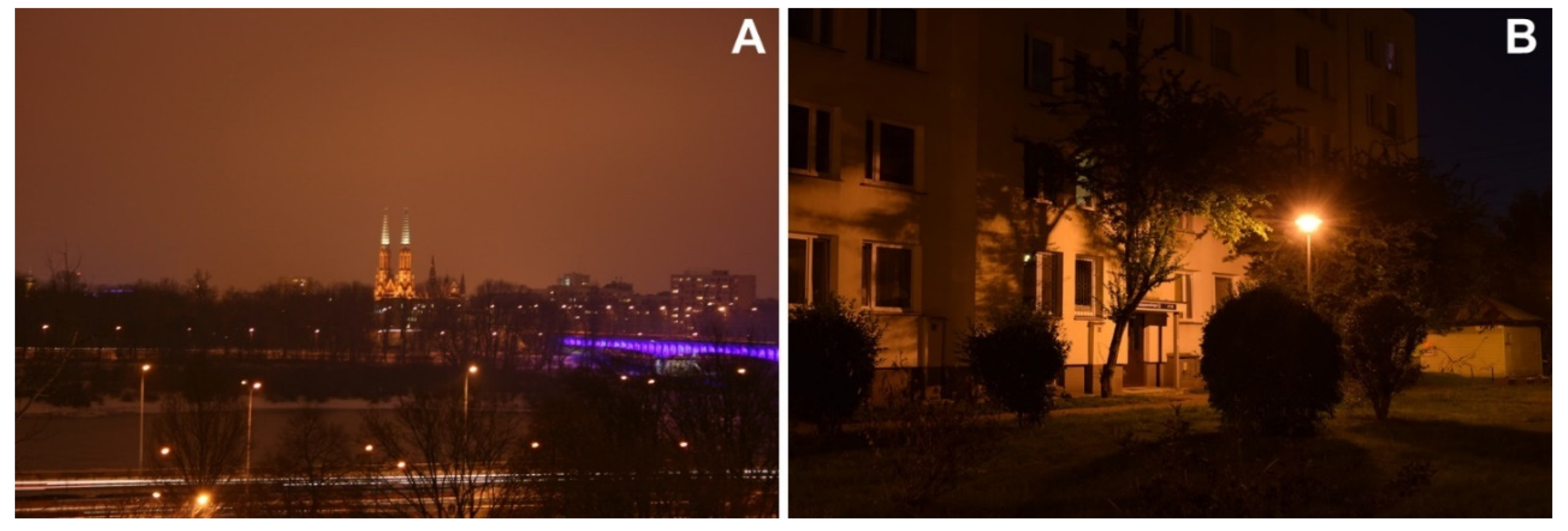
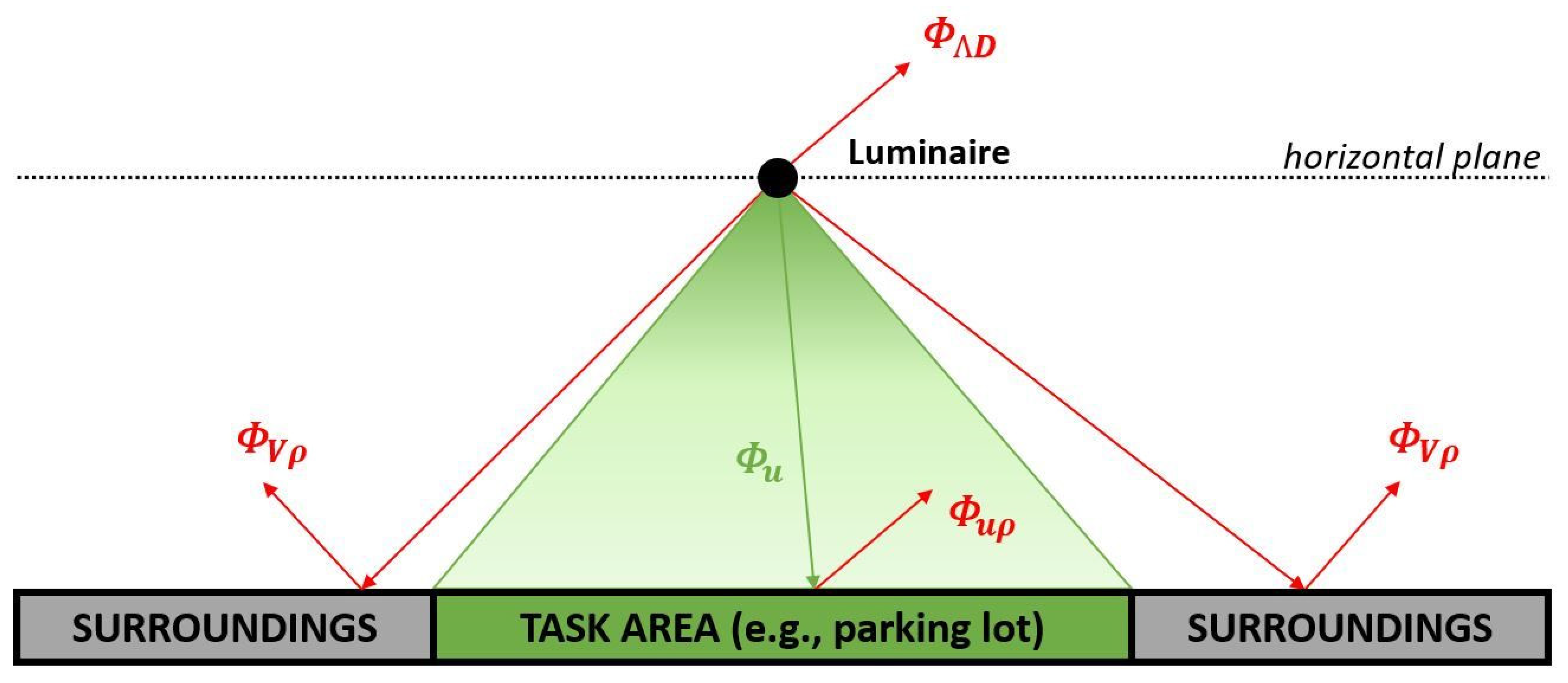
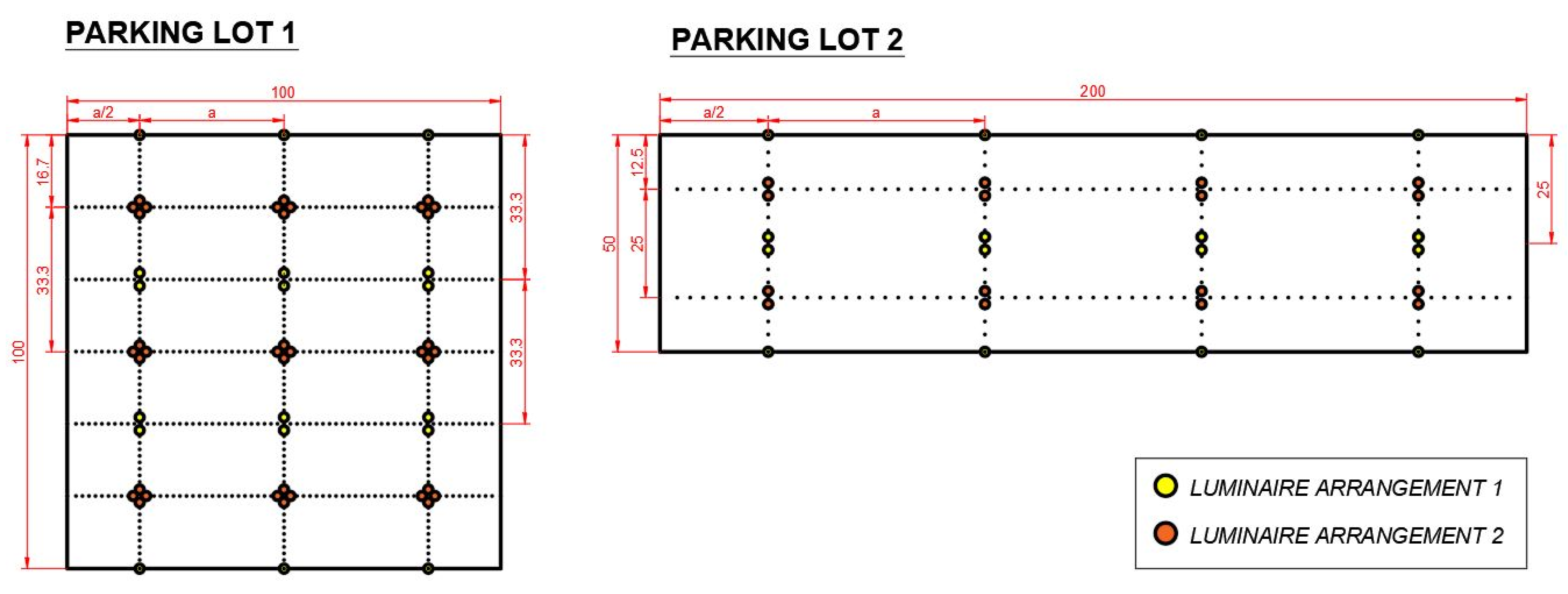
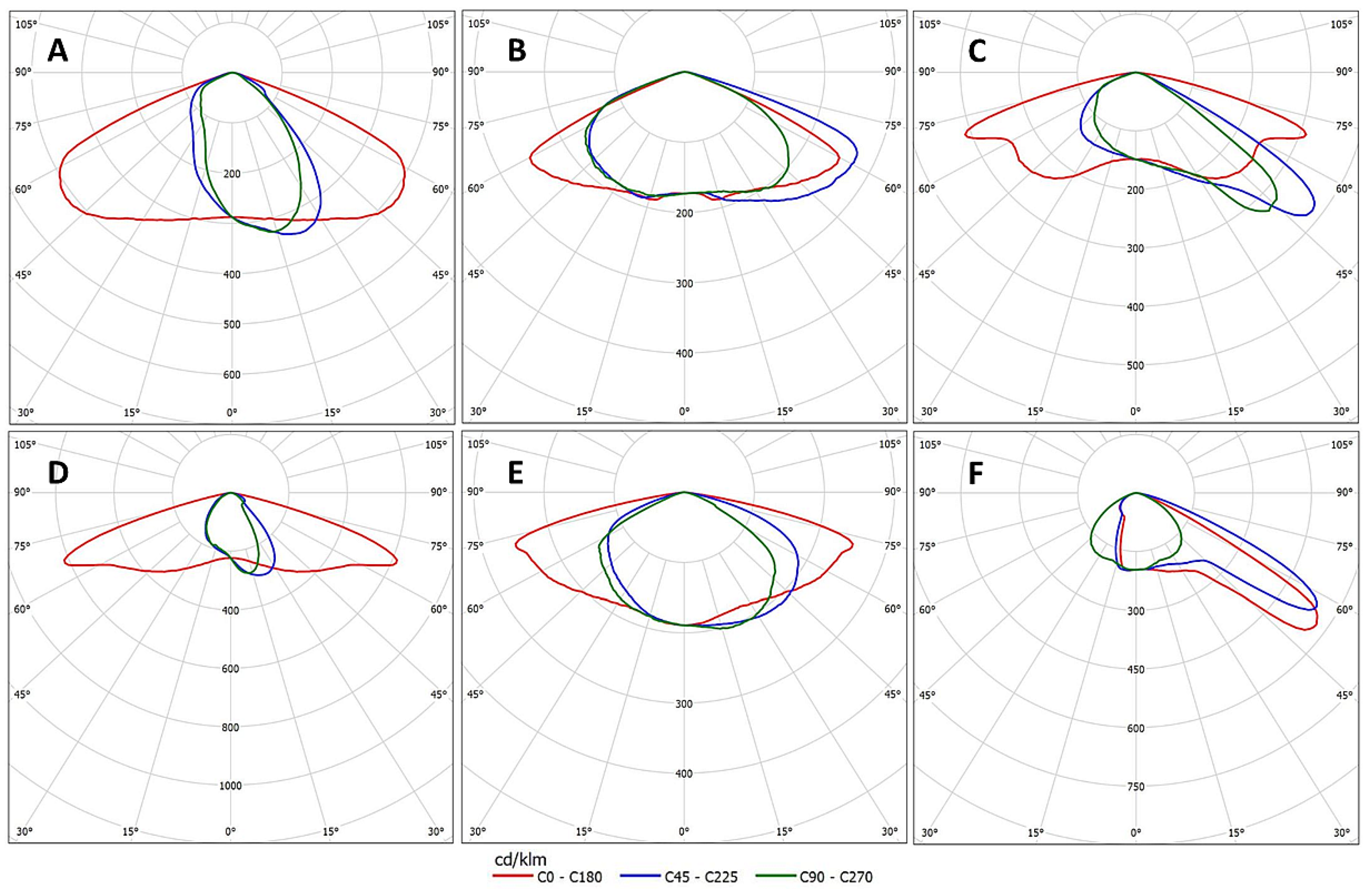
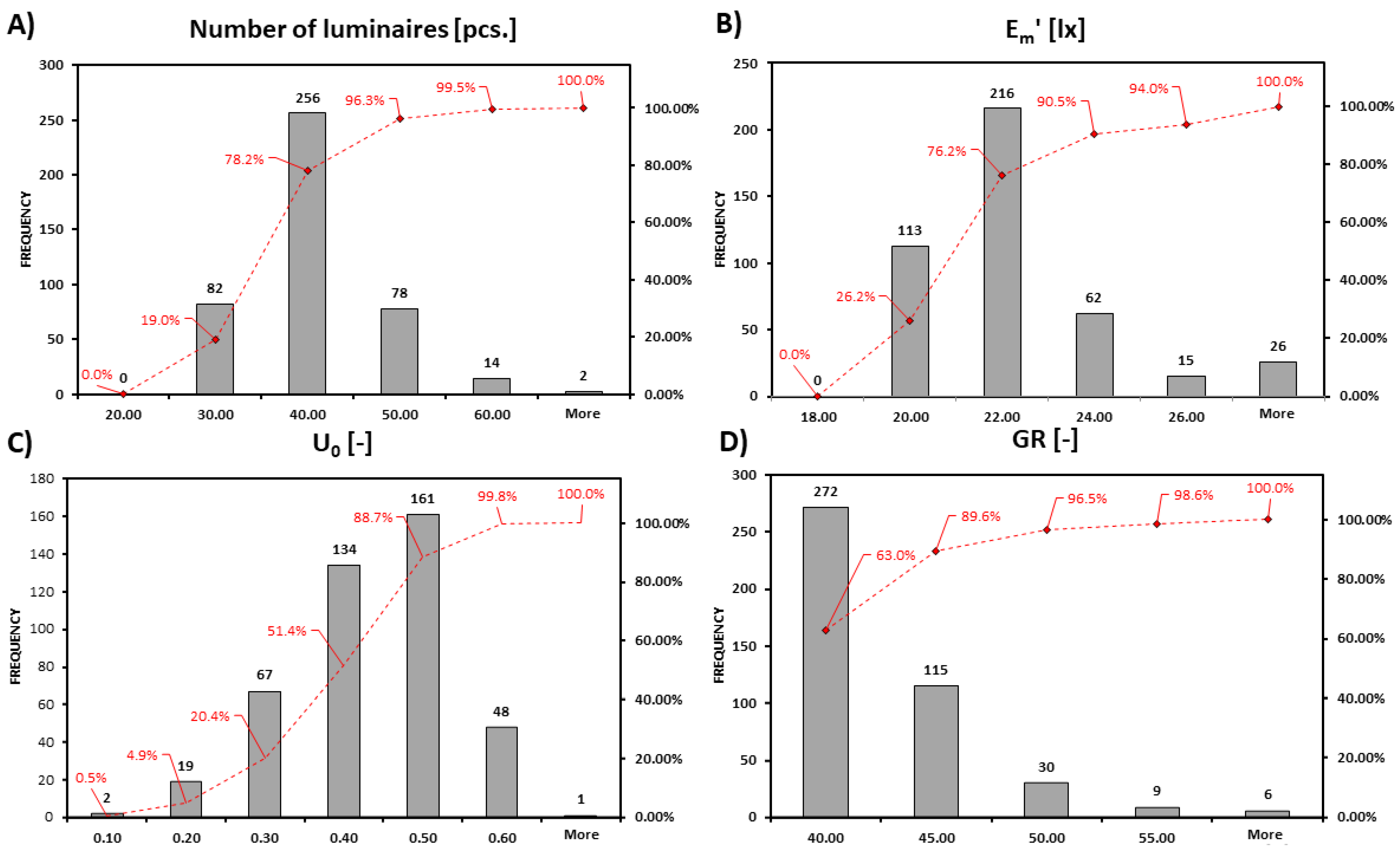


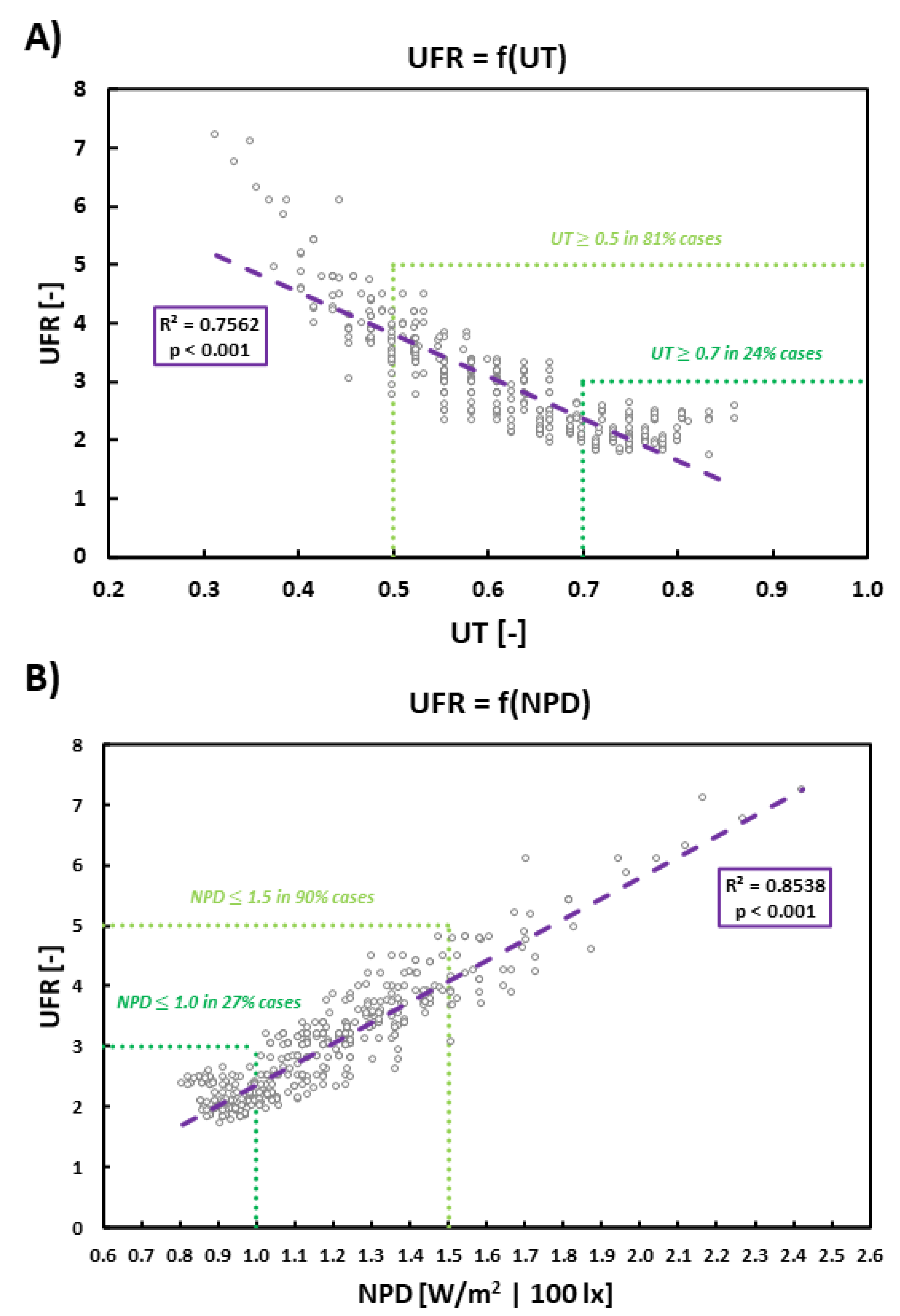
| Parameter | Environmental Zone | ||||
|---|---|---|---|---|---|
| E0 | E1 | E2 | E3 | E4 | |
| ULR [%] | 0 | 0 | 2.5 | 5 | 15 |
| UFR [–] | - a | - a | 6 | 12 | 35 |
| Em [lx] | U0 [–] | GR [–] | Zone | ULR [%] | UFR [–] | UT [–] | NPD [W/m2|100 lx] |
|---|---|---|---|---|---|---|---|
| 20 | 0.25 | 50 | E4 | 15 | 35 | 1 (100%) | 0 |
Disclaimer/Publisher’s Note: The statements, opinions and data contained in all publications are solely those of the individual author(s) and contributor(s) and not of MDPI and/or the editor(s). MDPI and/or the editor(s) disclaim responsibility for any injury to people or property resulting from any ideas, methods, instructions or products referred to in the content. |
© 2023 by the authors. Licensee MDPI, Basel, Switzerland. This article is an open access article distributed under the terms and conditions of the Creative Commons Attribution (CC BY) license (https://creativecommons.org/licenses/by/4.0/).
Share and Cite
Skarżyński, K.; Rutkowska, A. The Interplay between Parameters of Light Pollution and Energy Efficiency for Outdoor Amenity Lighting. Energies 2023, 16, 3530. https://doi.org/10.3390/en16083530
Skarżyński K, Rutkowska A. The Interplay between Parameters of Light Pollution and Energy Efficiency for Outdoor Amenity Lighting. Energies. 2023; 16(8):3530. https://doi.org/10.3390/en16083530
Chicago/Turabian StyleSkarżyński, Krzysztof, and Anna Rutkowska. 2023. "The Interplay between Parameters of Light Pollution and Energy Efficiency for Outdoor Amenity Lighting" Energies 16, no. 8: 3530. https://doi.org/10.3390/en16083530
APA StyleSkarżyński, K., & Rutkowska, A. (2023). The Interplay between Parameters of Light Pollution and Energy Efficiency for Outdoor Amenity Lighting. Energies, 16(8), 3530. https://doi.org/10.3390/en16083530





